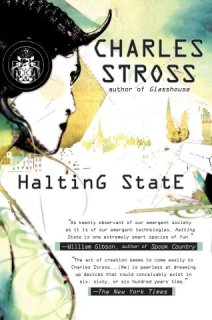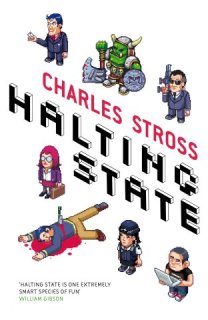Right now I'm (a) finishing a short story, (b) starting a novel, (c) rebuilding my office (which entails unloading, dismantling, moving, reassembling, and re-stacking six metres of full-height bookcases), and (d) about to head off to Novacon 37 at the weekend. So, apologies for the scarce posting. (By annoying coincidence, Novacon happens to be the same weekend as World Fantasy Con, which this year is somewhere in Long Island, and Utopiales in Nantes, both of which I wouldn't mind going to as well, but Novacon wins, for a reason that should be obvious if you look at their website.)
Meanwhile:
A question that comes up repeatedly in author interviews is, "what's with your sense of humour? Why are your books funny?" (Or whimsical, or just plain surreal.)
There seems to be a widespread belief that if literature is Serious, then it must be Humourless. (Serious has become a synonym for humourless in today's public discourse.) The division between the funny and the serious is pernicious. Usually when you see people mocking an institution or an idea, it implies there's something questionable about it; but people who derive power and status from their position (be it within an institution or for their endorsement of an idea) tend to dislike anything that undermines their platform — and so, they insist, it is Serious. Thus, there is an enforced split in many aspects of public life between the serious and the funny.
I suspect the literary canon has to some extent been pre-filtered for humourlessness by literary academics who are themselves humourless about their status. In the literature we are spoon-fed at school, "funny" isn't one of the selection criteria (unless you count Shakespeare's fart jokes and 16th century puns, which were doubtless thigh-slappers back in the day but require some translation for an audience of bored 15 year olds in the late 20th or early 21st century). And so, most readers are left with the educationally-installed belief that serious literature shouldn't be humorous or whimsical.
But the real world is contingent. The real world is weird. The real world is full of stuff that you couldn't get away with if you stuck it in a slapstick comedy. Case in point: this recent obituary from the Independent:
Sammy DuddyI mean, come on! If I stuck the late Mr Duddy in a novel, you'd think I was making him up. Right?
Belfast paramilitary and drag artist
Published: 19 October 2007Sammy Duddy, political activist, drag artist and poet: born Belfast 1945; twice married; died Belfast 17 October 2007.
Sammy Duddy was a colourful Belfast character who combined membership of one of the city's most lethal paramilitary groups with a career as "Samantha", a highly suggestive drag act.
In the 1970s, he was by day a propagandist for the Ulster Defence Association (UDA), the extreme Protestant group which was responsible for the killings of hundreds of Catholics. By night, however, he appeared on Belfast's limited but vibrant cabaret circuit, presenting a ribald act in loyalist pubs and clubs dressed in fishnet tights, wig and heavy make-up.
...
Regarded as a moderate in UDA terms, he found himself on the opposite side of the argument to more extreme figures such as Johnny "Mad Dog" Adair. On one occasion, Duddy's home was attacked with a pipe bomb, while on another shots were fired into it. While he was uninjured, his pet chihuahua, Bambi, was hit by gunfire and died.
And then there's the more esoteric stuff. Case in point: for one of my humour/horror crossover spoof lovecraftian spy thrillers — a planned sequel to "The Atrocity Archives" and "The Jennifer Morgue" — I'd decided to do something really bugfuck, and have the Royal Air Force flying a squadron of black Concordes, one of which would be armed with nuclear missiles.
You might think that the idea of nuclear-armed converted Concordes was daft, but you would be wrong; indeed, Prototype 002 was built with internal attachment points for a munitions bay, and an internal space that could be converted into a weapons store, to an RAF requirement: at one point in the late 1960s they were considering turning it into this, a supersonic replacement for the RAF's Vulcan bombers. So all that neat thechnothriller plot idea boiled down to in the end was running a couple of extra airframes off a production line, painting them in British Airways livery, and describing their movements as "charter flights" ... at a time when HMG thought nothing of blowing a cool billion pounds (back when that was real money) on a black project to design a new warhead system for Britain's Polaris missiles. (And they didn't even bother to inform the cabinet.)
Every time I think I've gotten a handle on how weird the real world is, it throws another curveball at me. So there's no way to keep up with the inherent strangeness of the universe without pulling on a rubber nose and the big old floppy shoes and making my fictional universes almost half as weird as the stuff I read in the newspapers every day.
Toot! Toot!


